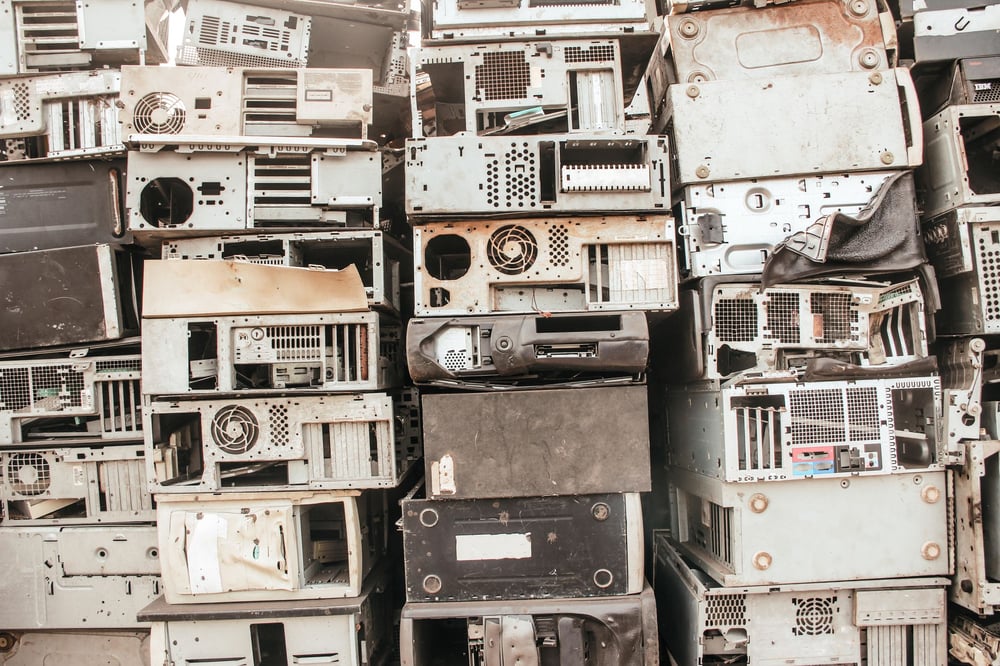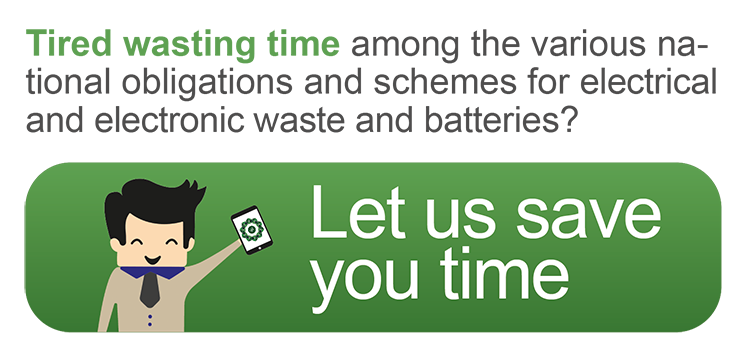1: Obligations for producers and retailers/distributors under the WEEE Directive
The WEEE directive and its national transpositions invites member states to arrive at a common understanding of the parties under obligation via the WEEE legal framework.
“EEE producer”: Companies placing a device (Electrical and Electronic Equipment, EEE) on the national market for the first time are responsible for organizing and managing WEEE compliance. This includes registration with the authorities; contracting with a producer responsibility organization (compliance, take back and recycling scheme) where necessary; reporting quantities and weights of WEEE placed on the market; financing the obligations; making information available for end users; reporting on take-back and recycling operations.
The first instance of placing a product on the market is usually attributed to the first company which applies VAT locally on the product, however, this should be verified by experienced lawyers or legal experts.
Such companies are considered to be “EEE producers” under the WEEE rules. A “EEE producer” can be an OEM with a registered company in the country as well as an importer (a distributor, an importer, etc.) company registered in the country or distance seller (company registered in another country).
An importer, a distributor, a reseller or a retailer can all be considered - legally speaking - as an “EEE producer” with a status of EEE importer. The directive gives the distributor definition under Article 3 as: “any natural or legal person in the supply chain, who makes EEE available on the market. This definition does not prevent a distributor from being, at the same time, a producer within the meaning of point (f)…”
Distributor obligations are defined as follows:
Article 5.2.b): “when supplying a new product, distributors are responsible for ensuring that such waste can be returned to the distributor at least free of charge on a one-to-one basis as long as the equipment is of equivalent type and has fulfilled the same functions as the supplied equipment…”
The act of returning WEEE must be free-of-charge for product user. Supplying a new product doe s not mean placing the product for the first tome on the local market. The distributor or the retailer might have two obligations: producer obligation and distributor obligation.
Article 5.2.c) states that:
“distributors provide for the collection, at retail shops with sales areas relating to EEE of at least 400 m2 , or in their immediate proximity, of very small WEEE (no external dimension more than 25 cm) free of charge to end-users and with no obligation to buy EEE of an equivalent type, unless an assessment shows that alternative existing collection schemes are likely to be at least as effective, …”
This is why regardless of EU country, WEEE drop off point or collection facilities can be seen today at many distributor and retailer sites as well as specific containers available off-site and sometimes on-street. The latter drop-off points are usually complementary to collective and municipal collection points.
It is important to understand the difference between producer obligations and the “specific” distributor obligation.
On the one hand, producers are required to report quantities of material placed on the market, make corresponding payments and contract with a producer responsibility organization to cover their take back and recycling obligations (municipalities, distributors, retailers, businesses etc.).
On the other hand, distributors, if obligated under the WEEE directive and/or local legal requirements, are required to accept returned devices as well as small devices. They can then contract with producer responsibility organizations, which will manage the associated take-back and treatment costs and operations.
A distributor might find itself in both positions: importing devices and placing them on the market for the first time in a country whilst also being a distributor under WEEE rules so required to accept returned devices.
2: Retailer and distributor selection criteria: transferring WEEE compliance management to suppliers
It can happen that distributors or retailers are also considered as an EEE producer in their country because they are the first entity placing EEE devices on the market in that country.
Some distributors belong to large corporate groups possessed of the competencies and staff to organize and manage compliance proceedings for a variety of products. However, some retailers or re-sellers are much smaller and lack awareness around producer responsibility obligations and definitions. Finally, some retailers, for one reason or another, simply refuse to manage compliance directly.
Distributors and retailers often request that WEEE compliance be managed by their suppliers, i.e. OEMs, procurement companies, fulfilment companies, importers, etc. The requirement usually emerges during the negotiation phase with sales representatives and sales teams, which are not always familiar with WEEE compliance obligations and the consequences of non-compliance.
It often happens that suppliers discover their implicit acceptance of these obligations through the sales contract signed between the two parties in which WEEE compliance management obligations are detailed as a duty managed by the supplier. Battery and packaging compliance obligations will also tend to be covered.
The supplier is then required to organize and manage compliance on a voluntary basis in order to make the deal or to satisfy its client(s). It is important to ensure that compliance is only managed by one party so as to avoid ‘double compliance’ (registrations, reporting, etc.) and duplicate payments.
Thus WEEE voluntary compliance management becomes a differentiator from a purchasing perspective.
3: The advantages of voluntary compliance
The satisfaction of clients will drive the company into a modern and qualitative positioning:
- Clients will see that the company really cares about compliance, quality and ethics
- Harmonization and simplification ensues with the company no longer managing compliance for material sold by client but by country or market
- Waste management recommendations and information made available in the same way for all clients whether they be distributors or product owners
- Take-back and recycling schemes can be organized on a larger scale if necessary
- RFQ (Request for Quotation) criteria regarding environmental and end-of-life compliance are no longer a problem
- End-of-life compliance criteria become an asset and business facilitator with other business clients in the same country (or countries).
4: How to simplify compliance management
Suppliers, OEMs, producers and licence or trademark owners can now take on their B2B clients’ WEEE compliance (battery and packaging where possible) obligations in order to facilitate market access for their products.
Additionally, companies may face multiple countries with legal obligations and/or voluntary compliance management.
If the company decides to harmonize this approach to compliance, then it will have to cope with multiple compliance obligations simultaneously in several countries.
Companies can either manage this internally by signing up to individual local producer responsibility organizations or companies can appoint a global compliance and recycling hub to act as a one-stop service co-ordinating proceedings centrally. The WEEElogic compliance hub acts as coordinator, organizer and central point of contact, mediating with all producer responsibility organizations for WEEE, batteries and packaging.
The support of a compliance hub enables the company to focus on its main business targets and sustains compliance management via dedicated tools and experts that facilitate both compliance and reporting proceedings.
Romain Letenneur



